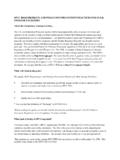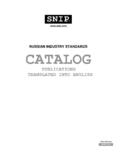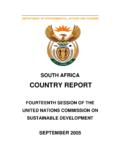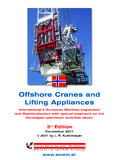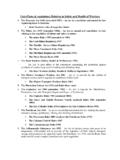Transcription of PRODUCTION OF AMMONIA - Fertilizers Europe
1 Best Available Techniques for pollution Prevention and control in the European Fertilizer industry Booklet No. 1 of 8: PRODUCTION OF AMMONIA . 2000. EFMA. European Fertilizer Manufacturers' Association Ave. E van Nieuwenhuyse 4. B-1160 Brussels Belgium Best Available Techniques for pollution Prevention and control in the European Fertilizer industry Booklet No. 1 of 8: PRODUCTION OF AMMONIA . Copyright 2000 EFMA. This publication has been prepared by member companies of the European Fertilizer Manufacturers' Association (EFMA). Neither the Association nor any individual member company can accept liability for accident or loss attributable to the use of the information given in this Booklet. Booklet No. 1 No. 5. Hydrocarbon feed Urea Water AMMONIA Air UAN. No. 2 No. 6. Water AN. Nitric Acid Air Calcium carbonate CAN. No. 3 No. 7. Water NPK. Sulphuric Acid Phosphate rock (nitrophosphate Sulphur route). K, Mg, S, micronutrients No. 4 No. 8. Water NPK. Phosphoric (mixed acid Phosphate Acid rock route).
2 K, Mg, S, micronutrients Phosphate rock 2. CONTENTS. PREFACE 4. DEFINITIONS 6. 1. INTRODUCTION 7. 2. DESCRIPTION OF PRODUCTION PROCESSES 7. PRODUCTION Processes in Operation in Europe 7. BAT PRODUCTION Processes 10. 3. DESCRIPTION OF STORAGE AND TRANSFER EQUIPMENT 18. Introduction 18. Storage Tanks 18. Transfer Equipment 19. 4. ENVIRONMENTAL DATA 21. PRODUCTION Input Requirements 21. PRODUCTION Output 22. PRODUCTION Emissions and Wastes 23. Environmental Data for AMMONIA Storage and Transfer 27. Environmental Hazards Associated with Emissions and Wastes 27. Emission Limits and Guideline Values for AMMONIA PRODUCTION in Some West-European Countries 27. 5. EMISSION MONITORING 28. 6. MAJOR HAZARDS 29. 7. OCCUPATIONAL HEALTH & SAFETY 29. 8. SUMMARY OF BAT EMISSION LEVELS 30. Achievable Emission Levels for New Plants 30. Achievable Emission Levels for Existing Plants 31. Cost of pollution control Measures 31. 9. REFERENCES 31. GLOSSARY OF TERMS 32. APPENDIX 1 Emission Monitoring in AMMONIA Plants 35.
3 APPENDIX 2 General Product Information on AMMONIA 40. 3. PREFACE. In 1995, the European Fertilizer Manufacturers Association (EFMA) prepared eight Booklets on Best Available Techniques (BAT) in response to the proposed EU Directive on integrated pollution prevention and control (IPPC Directive). These booklets were reviewed and updated in 1999 by EFMA experts drawn from member companies. They cover the produc- tion processes of the following products:- No. 1 AMMONIA No. 2 Nitric Acid No. 3 Sulphuric Acid (updated in collaboration with ESA). No. 4 Phosphoric Acid No. 5 Urea and Urea Ammonium Nitrate (UAN). No. 6 Ammonium Nitrate (AN) and Calcium Ammonium Nitrate (CAN). No. 7 NPK Compound Fertilizers by the Nitrophosphate Route No. 8 NPK Compound Fertilizers by the Mixed Acid Route The Booklets reflect industry perceptions of what techniques are generally considered to be feasible and present achievable emission levels associated with the manufacturing of the prod- ucts listed above.
4 The Booklets do not aim to create an exhaustive list of BAT but they high- light those most widely used and accepted. They have been prepared in order to share knowl- edge about BAT between the fertilizer manufacturers, as well as with the regulatory authorities. The Booklets use the same definition of BAT as that given in the IPPC Directive 96/61 EC. of 1996. BAT covers both the technology used and the management practices necessary to operate a plant efficiently and safely. The EFMA Booklets focus primarily on the technologi- cal processes, since good management is considered to be independent of the process route. The industry recognises, however, that good operational practices are vital for effective envi- ronmental management and that the principles of Responsible Care should be adhered to by all companies in the fertilizer business. The Booklets give two sets of BAT emission levels:- For existing PRODUCTION units where pollution prevention is usually obtained by revamps or end-of-pipe solutions For new plants where pollution prevention is integrated in the process design The emission levels refer to emissions during normal operations of typical sized plants.
5 Other levels may be more appropriate for smaller or larger units and higher emissions may occur in start-up and shut-down operations and in emergencies. 4. Only the more significant types of emissions are covered and the emission levels given in the Booklets do not include fugitive emissions and emissions due to rainwater. Furthermore, the Booklets do not cover noise, heat emissions and visual impacts. The emission levels are given both in concentration values (ppm, or ) and in load values (emission per tonne of product). It should be noted that there is not necessarily a direct link between the concentration values and the load values. EFMA recommends that the given emission levels should be used as reference levels for the establishment of regulatory authorisations. Deviations should be allowed as governed by:- Local environmental requirements, given that the global and inter-regional environ- ments are not adversely affected Practicalities and costs of achieving BAT.
6 PRODUCTION constraints given by product range, energy source and availability of raw materials If authorisation is given to exceed these BAT emission levels, the reasons for the deviation should be documented locally. Existing plants should be given ample time to comply with BAT emission levels and care should be taken to reflect the technological differences between new and existing plants when issuing regulatory authorisations, as discussed in these BAT Booklets. A wide variety of methods exist for monitoring emissions. The Booklets provide examples of methods currently available. The emission levels given in the Booklets are subject to some variance, depending on the method chosen and the precision of the analysis. It is important when issuing regulatory authorisations, to identify the monitoring method(s) to be applied. Differences in national practices may give rise to differing results as the methods are not internationally standardised. The given emission levels should not, therefore, be considered as absolute but as references which are independent of the methods used.
7 EFMA would also advocate a further development for the authorisation of fertilizer plants. The plants can be complex, with the integration of several PRODUCTION processes and they can be located close to other industries. Thus there should be a shift away from authorisation gov- erned by concentration values of single point emission sources. It would be better to define maximum allowable load values from an entire operation, eg from a total site area. However, this implies that emissions from single units should be allowed to exceed the values in the BAT Booklets, provided that the total load from the whole complex is comparable with that which can be deduced from the BAT Booklets. This approach will enable plant management to find the most cost-effective environmental solutions and would be to the benefit of our common environment. Finally, it should be emphasised that each individual member company of EFMA is responsible for deciding how to apply the guiding principles of the Booklets.
8 Brussels, April 2000. 5. DEFINITIONS. The following definitions are taken from Council directive 96/61/EC of 1996 on Integrated pollution Prevention and control :- Best Available Techniques mean the most effective and advanced stage in the develop- ment of activities and their methods of operation which indicate the practical suitability of particular techniques for providing, in principle, the basis for emission limit values designed to prevent or, where that is not practicable, generally to reduce emissions and the impact on the environment as a whole:- Techniques include both the technology used and the way in which the installation is designed, built, maintained, operated and decommissioned. Available techniques mean those developed on a scale which allows implementation in the relevant industrial sector under economically viable conditions, taking into consideration the costs and advantages, whether or not the techniques are used or produced inside the Member State in question, as long as they are reasonably accessible to the operator.
9 Best means most effective in achieving a high general level of protection for the envi- ronment as a whole. 6. 1. INTRODUCTION. This Booklet covers Best Available Techniques (BAT) for AMMONIA PRODUCTION , storage, and transfer. The description is partly based on Reference [1]. AMMONIA is produced basically from water, air, and energy. The energy source is usually hydrocarbons, thus providing hydrogen as well, but may also be coal or electricity. Steam reforming of light hydrocarbons is the most efficient route, with about 77% of world ammo- nia capacity being based on natural gas [2]. The total energy consumption for the PRODUCTION of AMMONIA in a modern steam reform- ing plant is 40-50% above the thermodynamic minimum. More than half of the excess con- sumption is due to compression losses. The practical minimum consumption is assumed to be about 130% of the theoretical minimum. The typical size of a large single-train AMMONIA plant is 1,000-1, , although capaci- ties of 1, and above are not uncommon for new plants.
10 In this Booklet 1, (500, ) will be considered as a standard capacity. The process and energy systems are integrated to improve overall energy efficiency. Further, the AMMONIA plant may stand alone or be integrated with other plants on the site, eg. a urea plant, but such integration is not covered in this Booklet. Plant battery limits are generally feedstock and fuel supply by pipelines at sufficient pres- sure for reforming; untreated water and air; and AMMONIA product stored as liquid, either refrigerated at atmospheric pressure or non-refrigerated at ambient temperature. In the case of steam and/or carbon dioxide export those battery limit conditions will depend on the receiv- er's requirements. The equipment and machinery used in today's large AMMONIA plants have achieved high reliabilities and technical on-stream factors in excess of 90% are common. 2. DESCRIPTION OF PRODUCTION PROCESSES. PRODUCTION Processes in Operation in Europe Two main types of PRODUCTION process for AMMONIA synthesis gas are currently in operation in Europe :- Steam reforming of natural gas or other light hydrocarbons (Natural Gas Liquids, Liquefied Petroleum Gas, Naphtha).


![1[SCHEDULE VI] - Welcome to Central Pollution …](/cache/preview/d/6/4/6/4/2/4/9/thumb-d6464249d79972a2e804a0aa4573c697.jpg)
